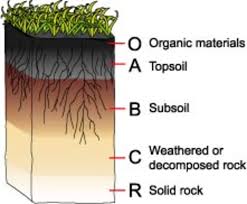SOIL PROFILE- DIFFERENT HORIZONS
DEFINITION
The vertical section of the soil through all its horizons from the ground surface extending downwards into parent material (Bedrock) is called soil profile.
Individual layers are called horizons. The soil is arranged in layers or horizons during its formation and can easily be identified by the soil color and size of soil particles. These horizons above the parent materials are collectively referred as solum (Latin word meaning soil).
The different layers of soil are broadly grouped into- Topsoil, Subsoil and parent material. Soil horizons differ in a number of easily seen soil properties such as color, texture, structure, and thickness while, other properties are less visible.
HORIZONS/LAYERS OF SOIL
The soil profile is composed of a series of horizons or layers represented by capital letters O, A, E, B, and C. let’s see one by one.

- “O” Horizon– This is upper layer of the topsoil which is mainly composed of organic materials, hence also called organic horizon. It contains about 20 to 30% of organic matter. This horizon of soil is often black brown or dark brown in color, mainly because of the presence of organic content. Such horizon is common in forest areas and visible in virgin soil.
- “A” Horizon– This is topmost mineral horizon consists of both organic matter and other decomposed materials. It contains strong humified organic matter hence also called humus layer. And so the darker color than others. In this layer, the seed germination takes place; microorganisms are also found.
- “E” Horizon– This layer is composed of nutrients leached from the O and A horizons i.e. horizon of maximum eluviation (Eluviation means removal of constituents in suspension or solution by the percolating water from upper layer to lower layer).
- “B” Horizon– It is the subsurface horizon comparatively harder and compact than top soil contains less humus, soluble minerals, and organic matter. it is Horizon of maximum illuviation (illuviation means deposition or accumulation of soil materials in the lower layers) of Fe, Al oxide and silicate clays.
- “C” Horizon– This is unconsolidated material beneath the solum. Accumulation of Ca, Mg, Carbonates and cementation take place. This is the site of least weathering.
- Parent material or bed rock– This is found below the “C” horizon, cemented layer, different type of rocks are present here.
Read more..
SOIL TEXTURE- CLASSIFICATION & INFLUENCE
FORMATION OF SOIL-PROCESS & FACTOR OF SOIL FORMATION
SOIL STRUCTURE-DEFINITION, FORMATION & TYPES
SOIL TYPES IN INDIA: FEATURES
SOIL CONSISTENCY- MEASURE AND ATTERBERG LIMIT
SOIL WATER- CLASSES AND AVAILABILITY
Acidic, Saline and Alkaline Soil